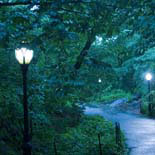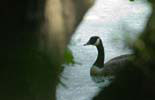 |
 |
 |
| Camp Pendleton | ||||||||
|
||||||||
 |
||||||||
 |
||||||||
 |
||||||||
Central Park New York
In profiling the most celebrated urban refuge in North America for Sanctuary, the 843 acre Central Park in Manhattan, DSF was fortunate to work with artist Cal Vornberger, one of the great photographers of birdlife in the world. For more than three years, Cal has made a daily pilgrimage into the park with his cameras to document the 270-odd bird species found there. (See Cal Vornberger, Birds Of Central Park, Foreword by Marie Winn, New York: Harry N. Abrams, Inc., Publishers, 2005).
But the park is also a haven for 26,000 trees of 200 species, at least 172 known insect species, 14 fresh-water vertebrate species, and numerous mammals, including
Big Brown Bats, Eastern Red Bats, Eastern Gray Squirrel, Raccoon, Eastern Cottontail, Deer Mouse, Common Raccoon, Woodchuck and Norway Rat - and, recently, a wandering coyote. In fact, during a 24-hour bio-marathon, 837 species were recorded.
Even the microbes and algae are now being investigated. One of the Central Park Conservancy’s long-time initiatives concerns environmental education and basic scientific research. Native tree and shrub recruitment is studied alongside those non-natives that were planted in the Park. Wildlife migrations take up a huge part of the study; also, soil analysis, flora and fauna disease vectors, the monitoring of plots to observe regeneration - and the ever present possibility of finding new species that have made their way into the Park. There has also been a number of bio-invasives in Central Park. For example, in the 19th century, one fellow brought every bird species ever written about by Shakespeare into the park. The millions of starlings across America date to those first immigrants.
If you want to be alone in the middle of New York, Central Park is the place. Sit on a quiet park bench, call it your own and ruminate on all the mysteries and beauties of this world.
Here the wilderness conjured up by Frederick Law Olmsted and Calvert Vaux remains consecrated ground. The sense of a sacred wilderness in the middle of busy lives was partly expressed by Ralph Waldo Emerson and lived out by Henry David Thoreau. The Metropolitan Museum of Art in Central Park also invites a meditation on that wilderness, as its collection includes many of the greatest American landscape paintings, particularly Hudson River School artists like Frederic Church and Albert Bierstadt, as well as the remarkable impressionist painter, George Inness.
Central Park, as President of Park Conservancy Doug Blonsky points out, has also rejuvenated Manhattan in some respects, becoming a haven for families to resettle the area. With 25 million visitors or so each year, this is one of the great sanctuaries on Earth.

